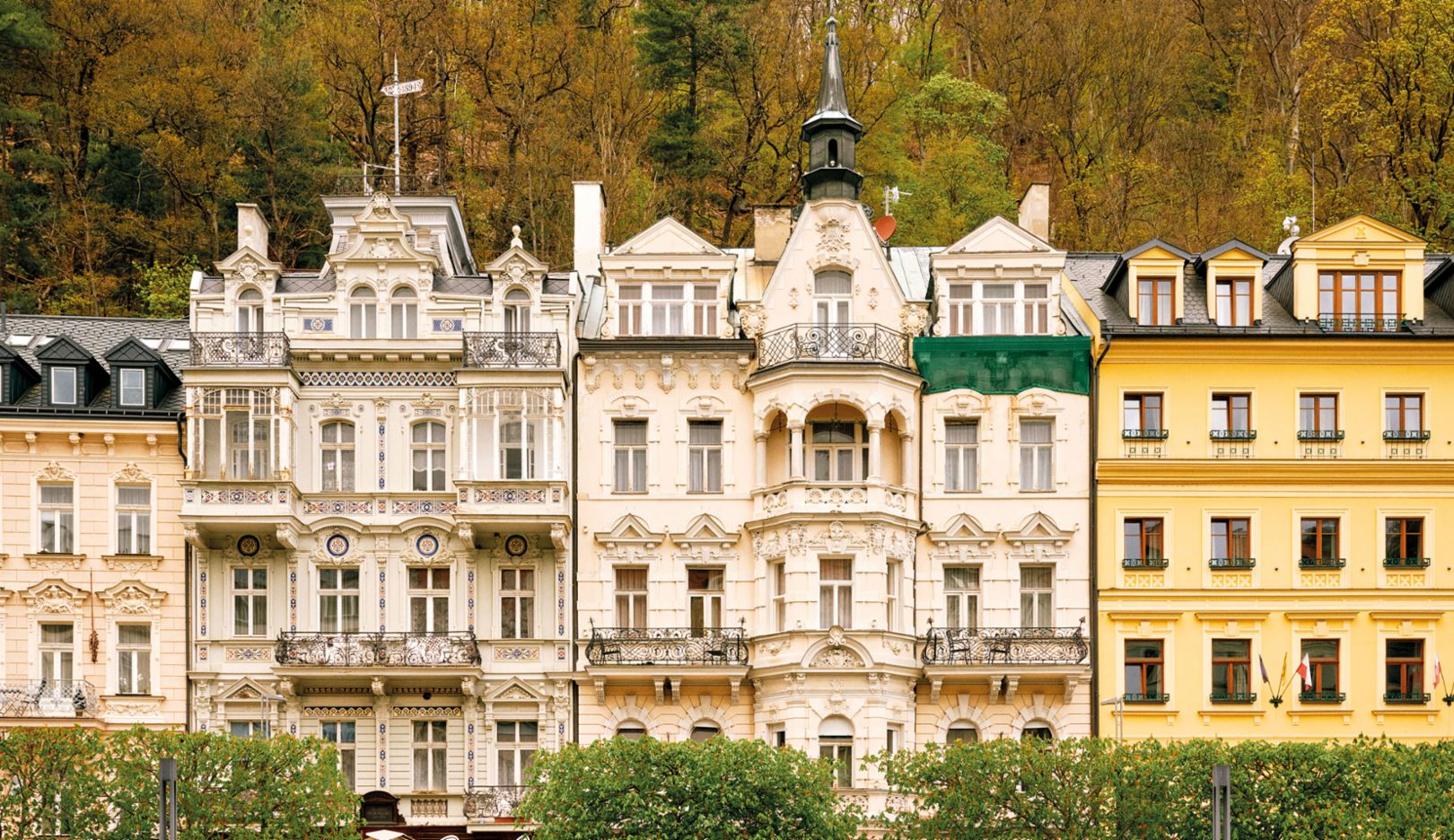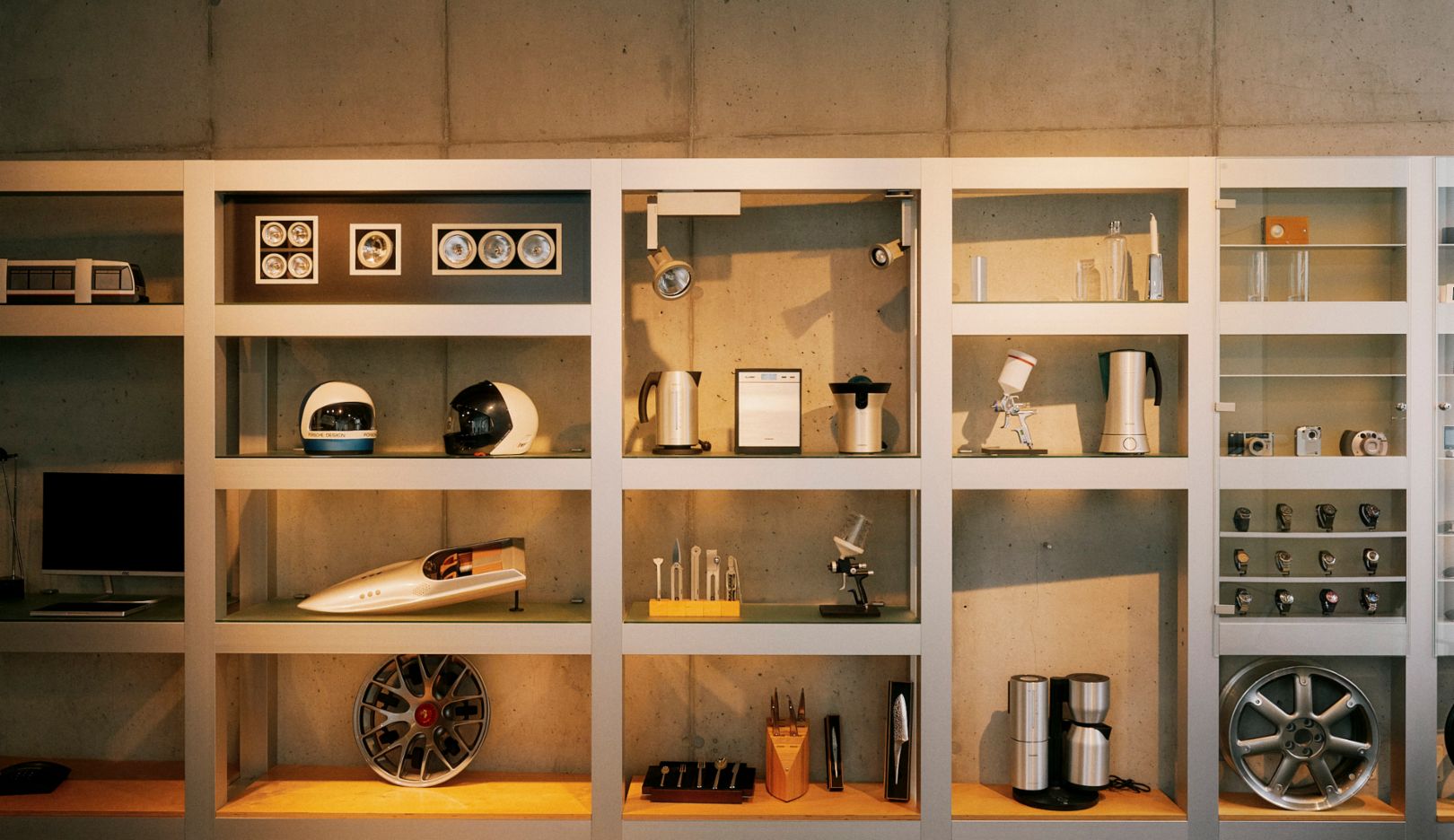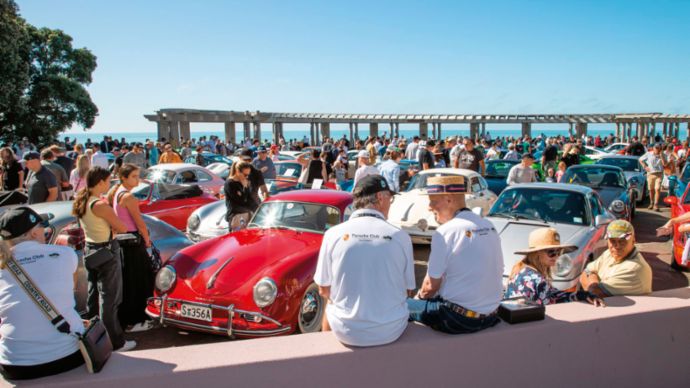Roadbook: Leipzig to Zell am See
Craggy rock formations in Germany’s Elbe Sandstone Mountains, deep forests in Czechia, spectacular lakes and peaks in Austria. On the trail of Porsche in a Panamera Turbo E-Hybrid, we visit places that are special in the history of the family and the company.

Start in Leipzig:
The Porsche Panamera Turbo E-Hybrid is ready for its history trail.Dark clouds are passing overhead and some of the asphalt is still wet as we turn onto the test track at the Porsche Experience Center in Leipzig. Behind us, the factory’s landmark soars into the sky like a huge diamond. The sun breaks through and we revel in being instructed on the capabilities of our Panamera Turbo E-Hybrid. Just like 5,000 customers from around the world who travel to Leipzig every year to collect their new sports car from the factory. Today, we pass on the opportunity to visit the factory. Because this is our starting point for an exciting journey on the trail of the Porsche family and company history.
Our first destination: Liberec in Czechia. To be precise, the Vratislavice nad Nisou district, formerly called Maffersdorf – the birthplace of company founder Ferdinand Porsche. Our picturesque route meanders southeast, before we make our first stop in the Elbe Sandstone Mountains soon after Dresden. Lush green beech forests, bright canola, apple blossom falling like snow. We stop at the Bastei Bridge.
The 76.5-meter-long structure has spanned the Mardertelle, a gorge that’s 40 meters deep, since 1851. From the bridge and rock formation, we look out over the Elbe. A ferry ripples through the water 190 meters below us. We can appreciate the inspiration that Romantic painter Caspar David Friedrich drew from these panoramas in the early 19th century.
The Panamera in Aventurine Green Metallic glides through the Saxon Switzerland National Park. It takes one corner after another as the spectacular landscapes fly by – the perfect backdrop against which to enjoy the car’s performance.

Birthplace:
Ferdinand Porsche was born in Vratislavice nad Nisou in 1875.
Oasis of relaxation:
In the heart of the Saxon Switzerland national park lies Bad Schandau. The town was first mentioned in the history books in 1445 and it has been famed as a spa town since 1800.Inside, the high-end Porsche Active Ride suspension is hard at work. It noticeably takes the driving comfort to a new level. Optimum traction and first-class cornering are usually at odds with driving comfort. The innovative suspension resolves this conflict. On the hairpin bends, the Panamera leans into the corner like a motorbike. And when accelerating, it leans forward like a helicopter. This is pure enjoyment – in keeping with the surroundings.
In Bad Schandau, there are neat rows of colorful little houses. The best views of this Kneipp spa town are offered by the elevator built in the Ostrau district in 1904. A quick detour takes us to Lichtenhain Waterfall, where the historical Kirnitzschtal tramway has just pulled up. This has been transporting people along the Kirnitzsch river for 126 years. We cross the border into Czechia and 90 minutes later we’re standing outside the house in which Ferdinand Porsche was born in 1875, in Vratislavice nad Nisou.
His father Anton once ran a forge here; these days, it’s a museum. Examples of historical engineering expertise can be explored here at Tanvaldská 38 Friday through Sunday. They document how far the design engineer was ahead of his time. In 1902, for example, he visited his place of birth in a hybrid car he built himself – the Lohner-Porsche Mixte. There is a photo of him driving his father and brother around what was then a small town and now has a population of more than 100,000.
We press on to Karlovy Vary – the famous spa town formerly known as Karlsbad. Undulating country roads take us through little villages. In the front gardens, fruit trees are in full bloom. Hop fields, pastures, and narrow brooks line our way. On an open stretch, we enjoy the Panamera uninterrupted. Dynamism meets comfort. Sports car meets sedan. And innovation meets tradition as we stop in the old part of Karlovy Vary with its mix of Gothic, baroque, and art nouveau buildings.

Rich architecture:
Karlovy Vary enjoyed great affluence in the 18th and 19th centuries. Many of the richly decorated town houses date back to this period.Goethe’s Lookout at the Three Crosses viewing point offers a good overview. The German poet also appreciated the spa town’s mineral deposits. Water has been gushing into the baths here since the Bronze Age. The minerals released form the crystalline rock aragonite, a popular souvenir. The Holy Roman Emperor Charles IV believed in the powers of the waters and had a castle built here in 1358. People have been bathing in and drinking the waters for health reasons since then. Today, too, we meet tourists sipping the spring water out of colorful cups. The spa town has been a UNESCO World Heritage site since 2021.

Healing springs:
Time appears to have stood still in Karlovy Vary, formerly Karlsbad. The beneficial effects of the waters from twelve hot springs have been appreciated for centuries.We continue on to Austria, passing Pilsen and České Budějovice as we go. The weather is a real mixed bag – there’s everything from freezing rain, sleet and hail to strong gusts of wind. The Panamera is put off neither by the bad weather, nor by the water on the roads. The sports car doesn’t lose any of its driving stability, and demonstrates its maximum agility. We arrive in Linz in the evening sunshine shortly before the sun sets over the Danube. We enjoy the spectacle from Salonschiff Fräulein Florentine, a permanently moored ship with an upper and lower deck, which is open all year round. It’s worth stopping here at any time of the day, be it for a leisurely breakfast, a coffee and a slice of Linzer torte – a pastry with redcurrant jam – in the afternoon, or a merry evening of music and dancing.

A stop with a view:
In addition to its famous torte, Linz boasts many small patisseries and confectioners with unusual ideas.
The next morning, we head toward the Mondsee and Attersee lakes. Their turquoise waters glisten, surrounded by steep, lush green banks. Small parking spots along the shore invite you to take a rest. Two neoprene-covered heads suddenly surface in the water. The lakes’ considerable depth makes them popular with divers. At their deepest, the Mondsee and Attersee lakes are 68 meters and an impressive 169 meters respectively. In the midst of this Alpine panorama, we savor a moment of peace before heading south. Wherever you look, the imposing mountain scenery seems almost mystical.
We pass Salzburg, catching a glimpse of the Hochkönig summit on our right, and take one mountain road after the other to reach our next destination after around 200 kilometers: Gmünd in the state of Carinthia. When the company had to relocate from Stuttgart due to the war, the remoteness of this place made it a comparatively safe construction and production site for Ferdinand Porsche and his team from 1944 to 1950. This is where the 356 “No. 1” Roadster was developed under the direction of Ferry Porsche in 1948 – the first sports car to bear the family name.

Curated collection:
In Gmünd, the Porsche Automuseum Helmut Pfeifhofer harks back to a time when the first Porsche sports cars were produced here. Christoph Pfeifhofer (below) is the second generation of the family to curate the collection.The Porsche Automuseum Helmut Pfeifhofer commemorates this, explaining early vehicle construction to visitors in a converted barn. Antique dealer Helmut Pfeifhofer founded the private museum in 1982. As a boy, he attended school with the sons of the design engineers of the time, and fell in love with the models. His son Christoph took over the Automuseum in 2001, preserving history and looking after the historical Porsche vehicles. Among them, a 914/6 in a racing design and featuring Walter Röhrl’s autograph. Also, the only 911 Carrera driven by the Austrian police. The space in the barn is finite, so a number of cars are parked in a garage. Christoph Pfeifhofer creates ever-changing exhibitions out of the treasures so that visitors regularly get to see different showpieces.


We get our warm jackets out of the trunk as we head up to the Katschberg Pass. When Porsche was based in Gmünd, the pass served as an unofficial test track. The mountain is 1,641 meters high and is snow-covered until late into spring. A paradise for our Panamera’s outstanding characteristics. We imagine the challenges of the early development test-drives without the high-end suspension that absorbs all the road unevenness today and allows us to glide around the hairpin bends. Then the mountain panorama leaves us speechless.
The destination at the end of today’s leg has a place in the company and family history, too. We reach a gem at Zell am See. The jagged roof ridge of Schloss Prielau appears at the end of a straight driveway. The castle’s first mention dates back to 1425. The building was given its current design in the 16th century. The castle then changed hands many times.
In 1932, Gerty von Hofmannsthal, widow of the famous Austrian writer and playwright Hugo von Hofmannsthal, bought the castle and restored it. The Porsche family eventually purchased the estate in Pinzgau in 1987 and turned the castle into a hotel. It has been run by Anette and Andreas Mayer since 2004, who treat their guests in their gourmet restaurant, Mayer’s. Andreas, once a student under Austrian celebrity chef Eckart Witzigmann, has earned many accolades, including two Michelin stars, four toques and 17 points from Gault&Millau, and 95 Falstaff points. Guests can dine in a high-end ambiance here between 7 p.m. and midnight, Wednesday through Sunday. Mayer’s aroma cuisine menu includes highlights such as Alpine shrimp, Pinzgau lamb, and squash. Naturally, the Michelin-starred kitchen also offers guests vegan and vegetarian dishes. Over the past 20 years, Anette Mayer has hosted more than 500 weddings on the estate for couples from all over the world. The Mayers are celebrating their 20th anniversary this year with all kinds of events.

Michelin-starred chef:
At Schloss Prielau, Andreas Mayer indulges his guests with his extravagant cuisine.Hotel Schloss Prielau has space for 22 guests, with the first floor being the centerpiece. The suite there boasts three bedrooms and two bathrooms for maximum exclusivity. Nearby is the Porsche family’s home track: the Großglockner High Alpine Road. The highest surfaced mountain pass road in Austria connects the two Austrian states Salzburg and Carinthia and covers close to 48 kilometers. From early summer to early fall, you can take narrow serpentine roads up to the Fuscher Törl and Hochtor mountain passes at over 2,500 meters. If you wish to enjoy the mountain summits up close, you should inquire in advance as to whether the road is open. We’re not so lucky, but Anette Mayer gives us a tip and sends us up the Mitterberg, which offers a phenomenal view of Lake Zell and the mountains.

A gem in Zell am See:
First documented nearly 600 years ago, Schloss Prielau has an eventful history. It is currently owned by the Porsche family and houses a hotel with a Michelin-starred restaurant.

Porsche Design:
Ferdinand Alexander Porsche moved his office to Zell am See 50 years ago. Today, a brand world is created here.Our last stop is likewise in Zell am See. We visit the design studio established by Ferdinand Alexander Porsche, the eldest son of Ferry Porsche, in 1972. Studio F. A. Porsche has been based in Pinzgau since 1974. The designer of the 911 created numerous classics here. To this day, Porsche Design creates glasses, watches, accessories, and even e-bikes. The office of the professor, who passed in 2012, remains untouched, as if he had just finished a sketch.
With the legendary designer in our thoughts, we look back on our trip. Would F. A. have enjoyed the Panamera as much as us? “Design must be functional,” was his supreme credo – which is evidenced by the Panamera Turbo E-Hybrid, too. A sports car and a luxury sedan at once – the perfect travel companion.
Journey through time
Drive the route yourself using the Roads by Porsche app.












